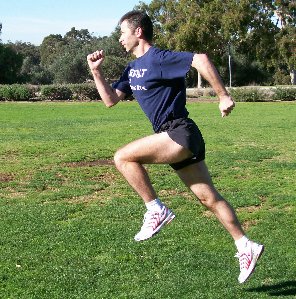Today I ran a hill circuit I created in Balboa Park in San Diego — a variety of bounding and sprinting drills to the top, turn left and jog to recover across the flat portion at the top, sprint down, turn left and sprint and across the flat portion at the bottom, and start the circuit all over again. I repeated the quarter mile square-shaped circuit a number of times until I got sufficiently tired.
This rather simple idea of running up and down a hill may seem monotonous and unnecessary to some, but hill repeats are a great method to improve fitness. The feel of my heart pounding in my chest and my shortness of breath at the top of the hill attest to the workout hill repeats provide for my cardiovascular system. But what about the workout they provide other muscles of my body? Surely they must do something for them too, right?
Indeed they do. Running up a hill repeatedly stimulates changes within the muscles in my legs. The quadriceps, calves, hip flexors and extensors, gluteals, even some of the muscles in my arms and shoulders all get a great workout, improving their strength and power. And I didn’t even have to lift a barbell or a dumbbell to do it. What I learn from running hills is that there is more than one way to train a muscle. You don’t necessarily have to lift a dumbbell to increase your muscular strength and endurance.
What ever happened to the old-fashioned push-up or chin-up? I remember being forced to do them in junior high and high school gym classes. We never went to the weight room during class and lifted weights. I used to think my gym teachers were old and fat and out of shape. What did they know about physical training anyway? After all, I was on the varsity cross-country and track teams. I was a stud.
But forcing my class to do chin-ups got me hooked. I used chin-ups to show off to the girls in class. I even bought a chin-up bar and attached it to my bedroom door post so I could train at home. I did chin-ups every day. Then came the big day at school—the day I would try to break the school chin-up record. I remember sitting in health class right before my record attempt. I was nervous. I wasn’t even listening to the health teacher talk about sex and foreplay and condoms. I was focused. After class I walked into the gym and got ready to perform my chin-ups on the bar on the back wall. The gym teacher acted as judge, making sure I didn’t cheat, that I completed the whole range of motion, with my arms straight at the bottom and my chin raised above the bar at the top. A small crowd formed. As I was closing in on the current record—21 chin-ups—my biceps grew tight, my forearms quivered, my body grew heavy. I felt like I weighed at least twice as much as my scrawny 125 pounds. I used the crowd to push me, and I let go of the bar after completing 22 chin-ups. The record was mine.
I finished eighth grade that year having broken my record again with 24 chin-ups. I received a certificate of accomplishment from the school’s principal that is still proudly displayed on my wall. I still brag about the accomplishment to others. It doesn’t matter so much that it was so many years ago or that some tough kid has probably come along since to break my record. At the time, I had the strongest biceps and forearms in eighth grade. I was a hero. My mother even bought a cake with a chin-up bar iced on it in chocolate and surprised me when I came home from school the day I broke the record.
Maybe those out of shape gym teachers were on to something. Maybe we should focus on increasing our strength to handle and master the weight of our own bodies instead of lifting external weights off the ground or attached to a machine. Maybe we should focus on improving our relative strength rather than our absolute strength. Maybe we should do chin-ups and push-ups after all. Mixed in with a few hills, of course.

